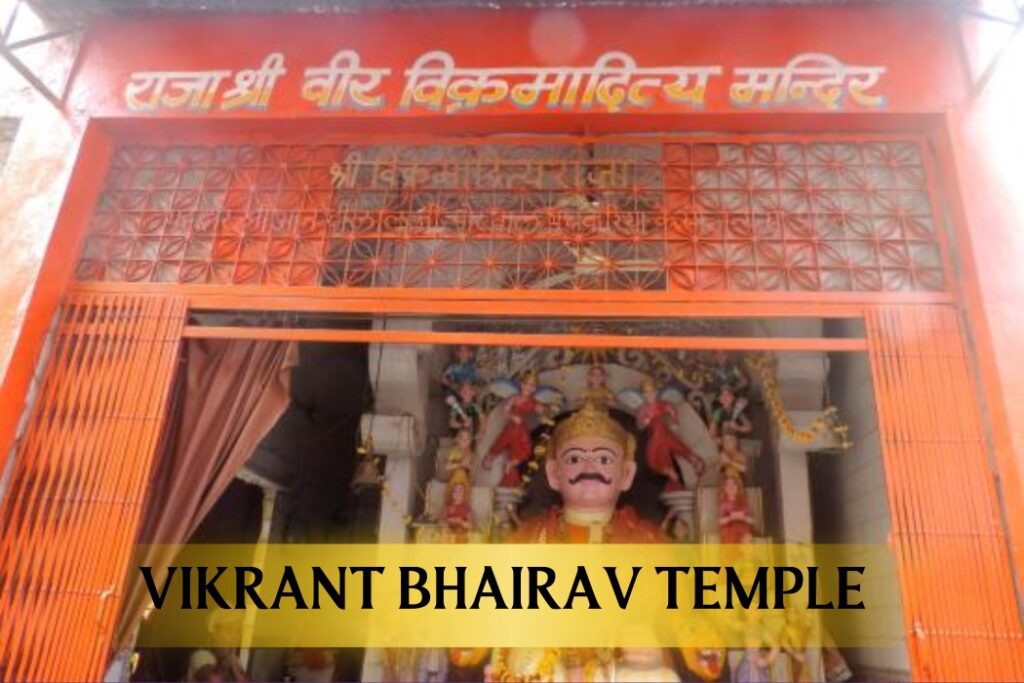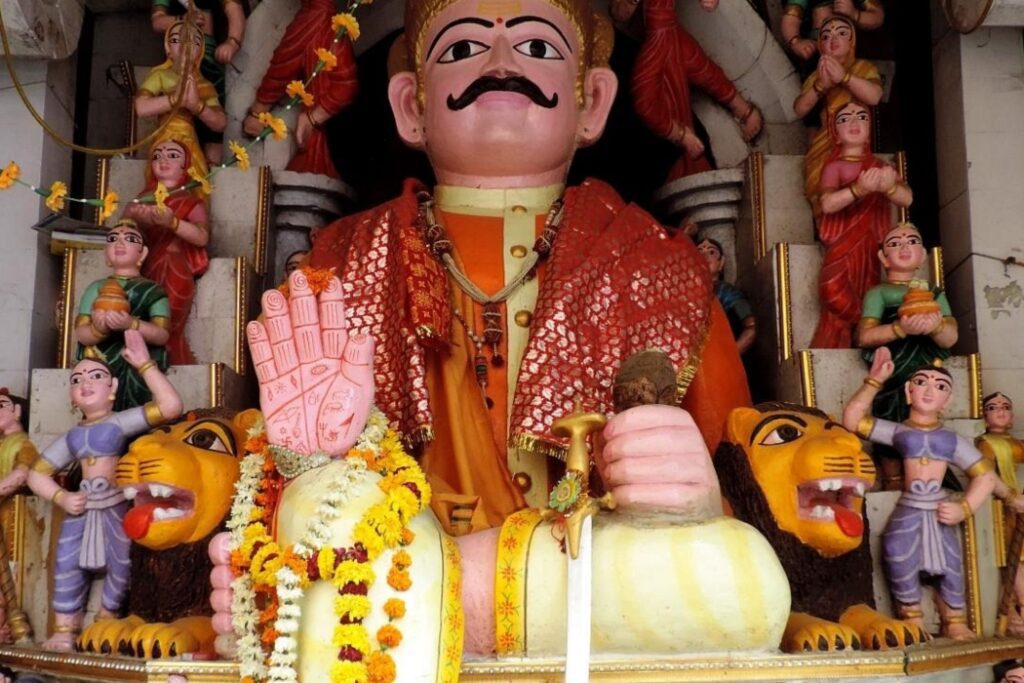Vikrant Bhairav Temple, Ujjain: History, Significance, and Travel

In Hinduism, Lord Bhairav is viewed as a wrathful manifestation of Lord Shiva, the deity of destruction. Lord Vikrant Bhairav is among the eight distinguished Bhairavas acknowledged in the Skanda Purana, an ancient Hindu text, and they dwell in the holy city of Ujjain. Vikrant Bhairav holds a significant position within these eight forms.
The temple of Vikrant Bhairav is also discussed in the Skanda Purana. Located on the northern shores of the Shipra River, it holds a unique relationship with a cremation site known as ankleshwar. This place of cremation is considered very holy and influential, with those cremated there being freed from the cycle of birth and death, attaining ultimate freedom or “Nirvana.”
This blog covers the history, architecture, top attractions, and serene ambiance that make Vikrant Bhairav Temple a fantastic destination to explore.
| Participate in online puja organised by VAMA (Get the puja done with your name and gotra) | |
| Name of Puja | Temple (Place) |
| Rin Mukti Puja | Rin Mukteshwar Mahadev Temple (Ujjain) |
| Tantra Badha Mukti Bhairav Mahasuraksha Yagya | Vikrant Bhairav Mandir,Ujjain |
| Shani Sade Sati | Shani Shingnapur Devsthanam ,Maharashtra |
| Vyapar Vriddhi Mahalakshami Puja Evam 108 Kanak Stotra Path | Mahalakshmi Temple,Maharashtra |
| Rahu Grah Shanti Puja | Jarkutinatheshwar Mahadev Temple, Prayagraj |
| Rahu-Ketu Shanti Puja | Rahu Temple, Paithani, Uttarakhand |
History and Story behind the Vikrant Bhairav Temple
The Vikrant Bhairav Temple, located in Ujjain, has an intriguing history closely connected to Baba Dabral’s life. Although the specific time period of when it was built is unknown, we understand that its present restoration is greatly attributed to Rani Ahilyabai Holkar of Indore during the 18th century.
However, the temple’s true story begins in 1960, when a divine pull led Baba Dabral to the Garh area, seeking a place of spiritual fulfilment. He visited the temples of Garh Kalika Devi, Siddhanath, and Kaal Bhairav, each step guiding him closer to his destiny.
One evening, while meditating in front of the Kaal Bhairav idol, Baba Dabral received a divine nudge to follow a path leading north. As luck would have it, he encountered an old Mahatma by the riverbank, who revealed he had been waiting for him. This mysterious figure instructed Baba Dabral to continue north, setting him on the final destination.
Reaching a solitary spot shrouded in darkness, Baba Dabral stumbled upon a mud-encrusted object. Guided by an unwavering resolve, he removed the mud, eventually unearthing the magnificent idol of Vikrant Bhairav. With a heart brimming with joy and awe, he lit lamps, offered flowers, and incense, marking the rediscovery of this ancient temple.
The story doesn’t end there. On a subsequent Diwali night, amidst complete darkness, Baba Dabral lit a lamp and offerings before the idol. Upon returning, he was left speechless. The once-desolate space was now bathed in the shimmering light of hundreds of lamps, with Vikrant Bhairav radiantly shining. This supernatural event solidified Baba Dabral’s faith and cemented the Vikrant Bhairav Temple’s significance.
From that time on, the temple has gained a sacred status as a destination for pilgrims who come seeking blessings and spiritual comfort. The rediscovery of it exemplifies the lasting strength of belief and the spiritual guidance that directs us to where we are meant to be.

Architecture of Vikrant Bhairav Temple
The Bhairav Parvat Shakti Peeth stands out for its unique architectural style. Unlike many temples that use uniform stone, this one boasts a fascinating variety of coloured stones. This colourful construction adds to the temple’s visual appeal and hints at the rich history it holds.
The temple walls and roof are further adorned with intricate and beautiful stone inscriptions. These carvings likely tell stories or hold religious significance, adding another layer of depth and history to the temple’s atmosphere.
The central figure of the temple, Devi Avanti, is always dressed in a vibrant red sari. In India, the colour red is seen as especially sacred by married women, symbolising prosperity and good fortune. This choice of colour for the idol reflects the importance and blessings associated with Devi Avanti and her presence at the temple.
Read this Blog to know about Alopi Devi Temple – Alopi Devi Mandir, Prayagraj: History, Significance, and Travel
Spiritual Significance and Festivals
The Vikrant Bhairav Temple hosts lively celebrations all year round, giving everyone a special chance to experience the divine energy of Vikrant Bhairavji. Here is an overview of some of the most notable festivities:
The Vikrant Bhairav Temple celebrates Bhairav Ashtami and Navratri with great importance. Both lasting for nine days, the events are characterised by devoted worship and aarti rituals carried out by Baba Dabral with great devotion. Worshippers gather at the temple in large numbers during this period, in search of blessings and joining in the spiritual enthusiasm.
Other significant celebrations such as Bhairav Ashtami and Navratri involve prolonged periods of worship, while Vikrant Bhairavji is also honoured with offerings and homage during various other important festivals annually. Included in this list are:
Tourist attractions around the Vikrant Bhairav Temple
Ujjain holds a unique significance for followers of the Hindu faith. It resembles an ancient city filled with numerous sacred tales. Visitors come from great distances to see it.
One well-known temple is Mahakaleshwar. Some say it suddenly materialized one day, as if by magic! It stands out because the statue of Lord Shiva is positioned towards the south, unlike in other temples. Individuals engage in unique activities and perform musical tunes in that place, creating a sense of tranquility.
Close to the Mahakaleshwar temple is a separate temple known as Vikrant Bhairav. It is intended for a powerful manifestation of Lord Shiva. Individuals visit the location to experience a sense of empowerment.
There is a temple dedicated to Goddess Parvati, known as the wife of Lord Shiva. The name of it is Gadh Kalika. The entire city is visible from that spot, and it is extremely peaceful and pleasant.
The Shipra River is unique as well. Individuals use it for bathing to experience a sense of cleanliness and well-being. You also have the option to take a boat tour and view the city from the river.
Ujjain is a location where one can experience a strong connection to God and gain knowledge about India’s past.
The focus of Bade Ganesh Temple is on Lord Ganesha, the god with an elephant head who represents wisdom and aids in conquering challenges. The temple is known for its massive Lord Ganesha statue. Located about 2 km from the Vikrant Bhairav Temple is where it is positioned.
The Chintaman Ganesh Temple, devoted to Lord Ganesha, is thought to fulfil the wishes of devotees. The Vikrant Bhairav Temple is about 2.5 km away.
How to Reach the Vikrant Bhairav Temple
The location of Vikrant Bhairav Temple is in Ujjain. Here is the procedure for obtaining it:
By Flight:
The nearest airport is located in Indore, approximately 70 kilometres from this location.
There are three transportation options available from Indore airport to travel to Ujjain: taxi, cab, or bus. This typically requires approximately 1 and a half to 2 hours.
By Train:
Ujjain has a railway station of its own. The temple is nearby, around 7 kilometres from this location.
You have the option to choose between a taxi, rickshaw, or auto to travel from the station to the temple. The journey is brief, lasting approximately 15 to 20 minutes.
By Road:
Buses to Ujjain are available from various regions across India.
Passengers can locate buses at the Ujjain bus station. From that point, you have the option to either hail a taxi or use an alternative mode of transportation to reach the temple.
Going on a journey using a vehicle.
It is possible to drive to Ujjain for your trip. Parking spots near the temple are easy to reach.
Temple built in honour of Vikrant Bhairav.
This temple is known for its devotion to Lord Bhairav, a powerful manifestation of Lord Shiva. It is calm and serene, an ideal spot for unwinding.

Want to know about Bhimashankar Jyotirlinga? Read this blog – Bhimashankar Jyotirlinga, Pune: History, Significance, and Travel




